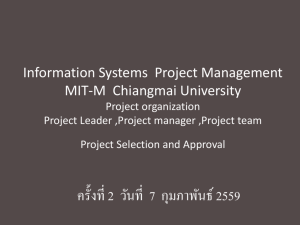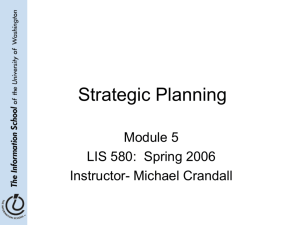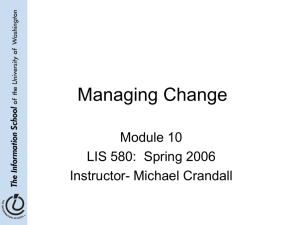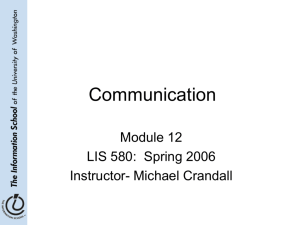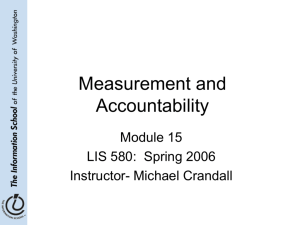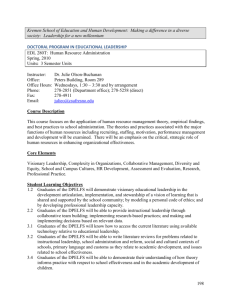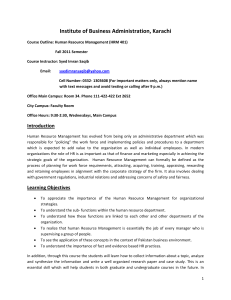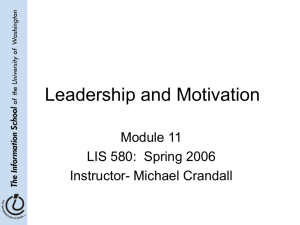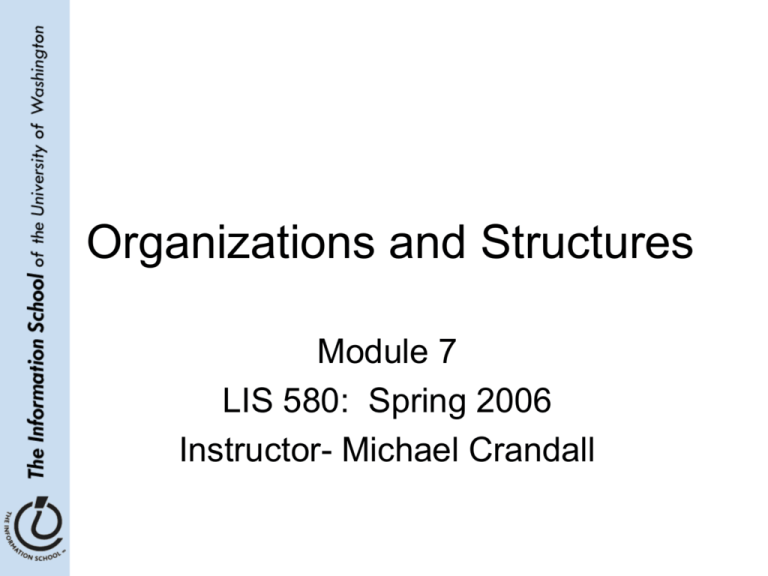
Organizations and Structures
Module 7
LIS 580: Spring 2006
Instructor- Michael Crandall
Roadmap
•
•
•
•
•
•
Organizing and organizations
Structure of organizations
Matrix organizations
Networked organizations
Learning organizations
Challenges in organizations
April 18, 2006
LIS580- Spring 2006
2
What Is Organizing?
• Organizing
– Arranging the
activities of the
enterprise in such
a way that they
systematically
contribute to the
enterprise’s goals.
G.Dessler, 2003
April 18, 2006
LIS580- Spring 2006
3
Depicting the Organization
• Organization Chart
– A chart that shows the
structure of the
organization including
the title of each
manager’s position
and, by means of
connecting lines, who
is accountable to
whom and who has
authority for each area.
G.Dessler, 2003
April 18, 2006
LIS580- Spring 2006
4
Organization Chart
Information Services Group
Knowledge Architecture Manager
Knowledge Architecture Lead
Customer Liaison
Search/Systems Lead
Developer
Design Lead
Assistant Designer
Developer
Cataloger
Systems Admin
Cataloger
Taxonomy Designer
April 18, 2006
LIS580- Spring 2006
5
Organization Design and
Structure
• Organization design
– A process in which managers develop or
change their organization’s structure
• Work specialization
– A component of organization structure that
involves having each discrete step of a job
done by a different individual rather than
having one individual do the whole job
Prentice Hall, 2002
April 18, 2006
LIS580- Spring 2006
6
Economies of Work
Specialization
Prentice Hall, 2002
April 18, 2006
LIS580- Spring 2006
7
Stages of Organizational
Development
• Simple structure
– An organization that is low in specialization
and formalization but high in centralization
• Functional structure
– An organization in which similar and related
occupational specialties are grouped
together
• Divisional structure
– An organization made up of self-contained
units
Prentice Hall, 2002
April 18, 2006
LIS580- Spring 2006
8
Stages of Organizational
Development (cont’d)
• Matrix structure
– An organization in which specialists from functional
departments are assigned to work on one or more
projects led by a project manager
• Team-based structure
– An organization that consists entirely of work
groups or teams
• Boundaryless organization
– An organization that is not defined or limited by
boundaries or categories imposed by traditional
structures
Prentice Hall, 2002
April 18, 2006
LIS580- Spring 2006
9
Mechanistic and Organic
Organizations
• Mechanistic organization
– The bureaucracy; a structure that is high in
specialization, formalization, and
centralization
• Organic organization
– An adhocracy; a structure that is low in
specialization, formalization, and
centralization
• Structure follows strategy
Prentice Hall, 2002
April 18, 2006
LIS580- Spring 2006
10
Burns and Stalker
G.Dessler, 2003
April 18, 2006
LIS580- Spring 2006
11
Structure Variables
• Principles
–
–
–
–
–
• Departmentalization
Chain of command
Span of control
Authority
Power
Responsibility
– Functional
– Divisional
•
•
•
•
Product
Customer
Geographic
Process
Prentice Hall, 2002
April 18, 2006
LIS580- Spring 2006
12
Organizational Structure: Control
• Chain of command
– The management principle that no person should report to
more than one boss
• Span of control
– The number of subordinates a manager can direct efficiently
and effectively
• Authority
– The rights inherent in a managerial position to give orders
and expect them to be obeyed
• Responsibility
– An obligation to perform assigned activities
• Power
– An individual’s capacity to influence decisions
Prentice Hall, 2002
April 18, 2006
LIS580- Spring 2006
13
Chain of Command
Prentice Hall, 2002
April 18, 2006
LIS580- Spring 2006
14
Tall And Flat Organizations, And
The Span Of Control
• Span of Control
– The number of subordinates reporting directly to a
supervisor.
• Wide spans: larger number of direct reports.
• Narrow spans: fewer number of direct reports.
• Tall vs. Flat Organizations
– Tall organizations: more management layers and
more hierarchical controls.
– Flat organizations: fewer management layer and
decision making closer to the customer.
G.Dessler, 2003
April 18, 2006
LIS580- Spring 2006
15
Spans of Control in Country-Based
Organization
FIGURE 6–9
G.Dessler, 2003
April 18, 2006
LIS580- Spring 2006
16
Types of Organizational Authority
• Line authority
– The position authority (given and defined by
the organization) that entitles a manager to
direct the work of operative employees
• Staff authority
– Positions that have some authority (e.g.,
organization policy enforcement) but that
are created to support, assist, and advise
the holders of line authority
Prentice Hall, 2002
April 18, 2006
LIS580- Spring 2006
17
Authority Versus Power
Prentice Hall, 2002
April 18, 2006
LIS580- Spring 2006
18
Types of Power
Legitimate
Power based on one’s position in
the formal hierarchy
Coercive
Power based on fear
Reward
Power based on the ability to
distribute something that others
value
Expert
Power based on one’s expertise,
special skill, or knowledge
Referent
Power based on identification
with a person who has resources
or traits
April 18, 2006
LIS580- Spring 2006
Prentice Hall, 2002
19
Checklist 7.3
Principles of Delegation
The manager can delegate authority but cannot
delegate responsibility.
Clarify the assignment.
Delegate, don’t abdicate.
Know what to delegate.
Specify the subordinate’s range of discretion.
Authority should equal responsibility.
Make the person accountable for results.
Beware of backward delegation.
G.Dessler, 2003
April 18, 2006
LIS580- Spring 2006
20
Departmentalization:
Creating Departments
• Departmentalization
– The process through which an
organization’s activities are grouped
together and assigned to managers; the
organizationwide division of work.
G.Dessler, 2003
April 18, 2006
LIS580- Spring 2006
21
Departmentalization
• Functional
– The grouping of activities by functions performed
• Product
– The grouping of activities by product produced
• Customer
– The grouping of activities by common customers
• Geographic
– The grouping of activities by territory
• Process
– The grouping of activities by work or customer flow
April 18, 2006
LIS580- Spring 2006
22
Organizing Departments by
Function
• Functional Departmentalization
– A form of organization that groups a
company’s activities around essential
functions such as
manufacturing,
sales, or finance.
G.Dessler, 2003
April 18, 2006
LIS580- Spring 2006
23
Functional Departmentalization
FIGURE 6–1
G.Dessler, 2003
April 18, 2006
LIS580- Spring 2006
24
Organizing Departments by SelfContained Divisions/Purposes
• Product Departmentalization
– Grouping departments around a firm’s
products or services, or each family of
products or services; also referred to as a
“divisional” organization.
• Customer Departmentalization
– Self-contained departments are organized
to serve the needs of specific groups of
customers.
G.Dessler, 2003
April 18, 2006
LIS580- Spring 2006
25
Divisional Organization
for a Pharmaceuticals Company
FIGURE 6–2
G.Dessler, 2003
April 18, 2006
LIS580- Spring 2006
26
Customer Departmentalization,
Grayson Steel Company
FIGURE 6–3
G.Dessler, 2003
April 18, 2006
LIS580- Spring 2006
27
Organizing Departments by SelfContained Divisions/Purposes (cont’d)
• Marketing-channel Departmentalization
– Departments focus on particular marketing
channels, such as drugstores or grocery
stores.
• Geographic (Territorial)
Departmentalization
– Separate departments are established for
each of the territories in which the
enterprise does business.
G.Dessler, 2003
April 18, 2006
LIS580- Spring 2006
28
Marketing Channel
Departmentalization
FIGURE 6–4
G.Dessler, 2003
April 18, 2006
LIS580- Spring 2006
29
Divisional Organizations
Facilitate Coordination
FIGURE 6–5
G.Dessler, 2003
April 18, 2006
LIS580- Spring 2006
30
Checklist 6.1
Functional vs. Divisional Organizations
Functional Organization Advantages
1.
2.
3.
4.
It is simple, obvious, and logical.
It fosters efficiency.
It can simplify executive hiring and training.
It can facilitate the top manager’s control.
Functional Organization Disadvantages
1. It increases the workload on the executive to
whom the functional department heads
report.
2. It may reduce the firm’s sensitivity to and
service to the customer.
3. It produces fewer general managers.
G.Dessler, 2003
April 18, 2006
LIS580- Spring 2006
31
Checklist 6.1 (cont’d)
Functional vs. Divisional Organizations
Divisional Organization Advantages
1. The product or service gets the singleminded attention of its own general
manager and unit, and its customers
may get better, more responsive
service.
2. It’s easier to judge performance.
3. It develops general managers.
4. It reduces the burden for the
company’s CEO.
G.Dessler, 2003
April 18, 2006
LIS580- Spring 2006
32
Checklist 6.1 (cont’d)
Functional vs. Divisional Organizations
Divisional Organization
Disadvantages
1. It creates duplication of effort.
2. It may diminish top management’s
control.
3. It requires more managers with
general management abilities.
4. It can breed compartmentalization.
G.Dessler, 2003
April 18, 2006
LIS580- Spring 2006
33
Creating Matrix Organizations
• Matrix Organization
– An organization structure in which
employees are permanently attached to
one department but also simultaneously
have ongoing assignments in which they
report to project, customer, product, or
geographic unit heads.
G.Dessler, 2003
April 18, 2006
LIS580- Spring 2006
34
Matrix Organization
Departmentalization
FIGURE 6–6
G.Dessler, 2003
April 18, 2006
LIS580- Spring 2006
35
Matrix Organizations
Advantages
• Access to expertise.
• Stability of
permanent
department
assignments for
employees.
• Allows for focus on
specific projects,
products, or
customers.
Disadvantages
• Confusion of
command.
• Power struggles and
conflicts.
• Lost time in
coordinating.
• Excess overhead for
managing matrix
functions.
G.Dessler, 2003
April 18, 2006
LIS580- Spring 2006
36
Departmentalization in Practice:
A Hybrid
• Why mix the types of departmentalization?
– Hierarchical considerations
• The relationship of top level departments to their
subsidiary departments.
– Efficiency
• Product, customer, and territorial departments tend to
result in duplicate sales, manufacturing, and other
functional departments.
– Common sense
• Departmentalizing is still more an art than a science.
G.Dessler, 2003
April 18, 2006
LIS580- Spring 2006
37
The New Summer Tour Organization
FIGURE 6–8
G.Dessler, 2003
April 18, 2006
LIS580- Spring 2006
38
Network-based Organizations
• Organizational Network
– A system of interconnected or cooperating
individuals.
• Informal Networks
– Communication pathways and relationships
between individuals in an organization that
do not necessarily conform to the formal
chain of command and communication
networks of an organization.
G.Dessler, 2003
April 18, 2006
LIS580- Spring 2006
39
Network-based Organizations
(cont’d)
• Formal Organizational Network
– A recognized group of managers or other
employees assembled by the CEO and the
other senior executive team, drawn from
across the company’s functions, business
units, geography, and levels.
• Electronic Organizational Networks
– Networking through technology-supported
devices such as e-mail, video-conferencing,
and collaborative computing software like
Lotus Notes.
G.Dessler, 2003
April 18, 2006
LIS580- Spring 2006
40
Formal vs. Social Structure
Rarely do the
communication patterns
match the formal
structure
Cross, Rob. A bird's-eye view: Using social network analysis to
improve knowledge creation and sharing. IBM Executive strategy
report 04Jun2002 http://www1.ibm.com/services/us/index.wss/xs/imc/a1001262
April 18, 2006
LIS580- Spring 2006
41
Network-based Organizations
(cont’d)
• Team-Based Organizations
– Team
• A group of people committed to a common purpose, set of
performance goals, and approach for which they hold
themselves mutually accountable.
• Horizontal Corporations
– A structure that is organized around customeroriented processes performed by multidisciplinary
cross-functional teams rather than by formal
functional departments.
G.Dessler, 2003
April 18, 2006
LIS580- Spring 2006
42
The Horizontal Corporation
Source: John A.
Byrne, “The Horizontal
Corporation,” Business
Week, 20 December
1993, p. 80.
April 18, 2006
FIGURE 6–11
G.Dessler, 2003
LIS580- Spring 2006
43
Checklist 6.2
Building Horizontal Organizations
Make responsibilities overlap. Design
individual jobs as broadly as possible, and
keep the number of job titles to a minimum.
Base rewards on unit performance to
emphasize the importance of working
together.
Change the physical layout to promote
collective responsibility. Let people see each
other’s work.
Redesign work procedures, provide computer
terminals, use the e-mail network, and make
sure managers are available.
G.Dessler, 2003
April 18, 2006
LIS580- Spring 2006
44
How to Create a Horizontal
Corporation
Source: Source: Reprinted from the December 20, 1993, issue of Business Week
by special permission. Copyright © 1993 by the McGraw-Hill Companies, Inc.
April 18, 2006
LIS580- Spring 2006
FIGURE 6–12
G.Dessler, 2003
45
Other Organization Types
• Federal Organization
– An organization in which power is distributed
between a central unit and a number of
constituents, but the central unit’s authority is
intentionally limited.
• Virtual Organization
– A temporary network of independent companies
that use information technology to share skills,
reduce costs, and provide access to one another’s
markets.
– Its success depends on each of the individual
firms’ responsibility and self-interest to accomplish
the network’s purpose.
G.Dessler, 2003
April 18, 2006
LIS580- Spring 2006
46
Effect of Technology on Structure
G.Dessler, 2003
April 18, 2006
LIS580- Spring 2006
47
When Organizing:
Always Keep Your Goals in Mind
• Business environments are in a constant state
of change.
• An organization’s strategy must be adapted to
changes in its competitive environment.
• Structure follows strategy.
– Strategic change creates the need for restructuring
the organization to acquire new and different
knowledge, skills and abilities.
G.Dessler, 2003
April 18, 2006
LIS580- Spring 2006
48
Checklist 7.1
What Determines Organization Structure
Environment. Fast-changing environments
require organic structures; slowly changing
environments favor mechanistic structures.
Technology. Unit and continuous production
processes favor organic structures. Mass
production processes favor mechanistic structures.
Goals. Ask, “What are the main goals we want to
achieve via this organization?”
Pros and cons. Each approach to
departmentalization has pros and cons.
Logic and common sense.
G.Dessler, 2003
April 18, 2006
LIS580- Spring 2006
49
What Are Learning
Organizations?
1. Adopt an organic, networked organizational
form.
2. Encourage their employees to learn and to
confront their assumptions
3. Have employees who share a common vision
4. Have the capacity
•
•
•
•
to adapt to unforeseen situations
to learn from their own experiences
to shift their shared mindsets
to change more quickly, broadly, and deeply than
ever before.
G.Dessler, 2003
April 18, 2006
LIS580- Spring 2006
50
Organizational Learning as a
Dynamic Process
Crossan, Lane, & White (1999)
April 18, 2006
LIS580- Spring 2006
51
Abolishing Organizational
Boundaries
• Boundaryless Organization
– An organization in which management
strips away the “walls” which typically
separate organizational functions and
hierarchical levels, through
the widespread use of
teams, networks, and
similar structural
mechanisms.
G.Dessler, 2003
April 18, 2006
LIS580- Spring 2006
52
The Four Organizational Boundaries
That Matter
Source: Reprinted by permission of Harvard Business Review. “The Four Organizational Boundaries that Matter,”
from “The New Boundaries of the Boundaryless Company,” by Larry Hirschorn and Thomas Gilmore, May–June
1992. Copyright © 1992 by the President and Fellows of Harvard College. All rights reserved.
April 18, 2006
LIS580- Spring 2006
FIGURE 0–3
G.Dessler, 2003
53
Managing Learning Organizations
• How to Streamline Organizational Decision
Making
– Downsize
– Reduce management layers
– Establish miniunits
• How to Cultivate Employees’ Personal
Mastery
– Provide continuous learning opportunities.
– Foster inquiry and dialogue.
– Establish mechanisms to ensure that the
organization is continuously aware of and can
interact with its environment.
G.Dessler, 2003
April 18, 2006
LIS580- Spring 2006
54
Challenges in Organization
• Merging separate organizations with different
structures
• Changing an existing organization to meet
external or internal changes in conditions
• Conflicts between departments or groups
• Interdependence between organizational units
• Centralization vs. decentralization
April 18, 2006
LIS580- Spring 2006
55
Part of the “Independent Integrator” Challenge
Facing the Homeland Security Director
Source: Alison Mitchell, “Disputes Erupt over Ridges Needs
for His Job,” New York Times, 9 November 2001, p. B7.
April 18, 2006
FIGURE 7–5
G.Dessler, 2003
LIS580- Spring 2006
56
Methods for Achieving
Coordination
• Mutual Adjustment
– Achieving coordination
through face-to-face
interpersonal
interaction.
• Use Rules and
Procedures
• Standardize
• Exercise Direct
Supervision: Use the
Chain of Command
• Divisionalize
• Appoint Staff
Assistants
• Appoint Liaisons
• Appoint Committees
• Organize Independent
Integrators
– An individual or a group
that coordinates the
activities of several
interdependent
departments, but is
independent of them.
G.Dessler, 2003
April 18, 2006
LIS580- Spring 2006
57
Managing Organizational Conflict
• Line–Staff Conflict
– Disagreements between a line manager
and the staff manager who is giving him or
her advice.
• How to Organize to Reduce Interunit
Conflict
– Appeal to power and
the chain of command
– Reduce interdependence
– Exchange personnel
G.Dessler, 2003
April 18, 2006
LIS580- Spring 2006
58
Types of Interdependence
Source: Based on James Thompson, Organizations in Action
(New York: McGraw-Hill, 1967), Chapter 2.
April 18, 2006
FIGURE 7–6
G.Dessler, 2003
LIS580- Spring 2006
59
Centralization and
Decentralization
• Centralization
– A function of how much decision-making
authority is pushed down to lower levels in
an organization; the more centralized an
organization, the higher the level at which
decisions are made
• Decentralization
– The pushing down of decision-making
authority to the lowest levels of an
organization
Prentice Hall, 2002
April 18, 2006
LIS580- Spring 2006
60
Decentralize?
• Decentralized Organization
– Organizational authority for most departmental
decisions is delegated to the department heads.
– Control for major companywide decisions is
maintained at the headquarters office.
• Decentralization Rules:
– Decentralize decisions that affect only one division
or area and that would take a long time for upper
management to make.
– Centralize decisions that could adversely affect the
entire firm and that upper management can fairly
quickly and easily.
G.Dessler, 2003
April 18, 2006
LIS580- Spring 2006
61
Problems With Size
• “There is a fairly common perception that large organizations
tend to behave much less “intelligently” than their size suggests.
They often lose the decisiveness seen in small groups and may
seem "stupid" to people within them who work with ideas and
knowledge.”
• “There appears to be a fundamental upper limit on the average
per capita decision rate that an organization can sustain,
depending inversely on the organization's entropy. If the limit is
broached, impaired productivity among knowledge managers
may result and large organizations may be disadvantaged when
performing knowledge-intensive tasks that require efficient use
of intellectual capital.”
Janow, R. Shannon “Entropy and Productivity: Why Big Organizations Can Seem Stupid”. Analytic Solutions Group, LLC. 2/28/2004
http://physics.njit.edu/~janow/Paper20040228njit.pdf
April 18, 2006
LIS580- Spring 2006
62
Hammer vs. Deming
• What tradeoffs did Deming and Hammer
make in their approaches to designing
organizations?
• Did you notice who was given power in
Deming’s approach vs. Hammer?
• What is driving NYNEX to make changes in
their organization structure?
• What component of the organization is
hardest to change?
• Do you see the same issues arising in the
“War at Work” article?
April 18, 2006
LIS580- Spring 2006
63
Next Time
•
Managing People
– Read Chapter 9 (not 8!!) and the articles
•
Discussion group questions:
– How can relations be improved between Stanley
and the reference librarians?
– How, without simply complaining about Stanley,
can you persuade Joanna to listen to the
reference department’s perspective?
– Who defines the responsibilities of each
department, and how can you, as an interested
party, help accomplish this?
April 18, 2006
LIS580- Spring 2006
64

